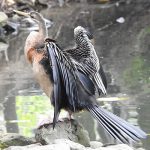AUSTRALIAN DARTER
In the shimmering wetlands of Australia, where water lilies drift and dragonflies dart, the Australian darter glides silently beneath the surface. Commonly known as the Australian snakebird, this remarkable species is a master of stealth and grace. Its long, slender neck and sharp bill are perfectly adapted to its watery world, making it one of the continent’s most fascinating waterbirds.
Appearance and Adaptations
Imagine a bird that moves like a shadow through water, its neck arched like a question mark. The Australian darter is medium-sized but made striking by its elegant silhouette:
- Plumage: Predominantly black with striking silvery-white streaks across the wings and back, which glint in the morning sun.
- Breeding Features: Come spring and summer, adults adorn themselves with delicate white plumes on their neck and upper back—a seasonal transformation that signals the breeding season.
- Neck and Bill: The neck is so long and flexible, it brings to mind a snake rising from the depths, while the bill is needle-sharp and perfectly designed for fishing.
Multi-Sensory Impressions
Picture cool morning air thick with the scent of damp earth and water plants. The darter moves with barely a ripple, the subtle feather patterns catching the dappled light. When it surfaces, droplets roll down its sleek feathers, glinting like tiny jewels.
Unique Behaviour
The darter’s behaviour is as fascinating as its appearance:
- Swimming Style: Often mistaken for a cormorant, the darter is distinguished by its habit of swimming with its body submerged. Only the sinuous neck and head emerge, evoking the shape of a snake poised to strike.
- Feeding: Underwater, the darter is an agile hunter, using its sharp bill to spear fish with astonishing precision. Its movements are fluid and almost balletic in their grace.
- Vocalisations: In the hush of dawn, one might hear their soft clicking or rattling while flying or perching. In breeding colonies, these are complemented by deeper croaks and grunts—a subtle, living soundtrack of the wetland world.
Life Cycle & Breeding
With the rise of spring, breeding season begins:
- Nesting: Darters construct robust nests from sticks and reeds, often high in the arms of trees above the water, safe from many predators.
- Colony Life: Nests are frequently built close together, creating a bustling community alongside other waterbirds. The air fills with the mingled calls and the hum of life.
- Parental Care: Both parents share incubation duties. Once hatched, chicks are fed regurgitated fish, nurturing the next generation in these vibrant nurseries.
Ecological Role and Conservation
The darter is not just a stunning spectacle but a key player in its ecosystem:
| Ecological Role | Conservation Challenges |
|---|---|
| Predatory control of fish | Habitat loss from wetland drainage and urban development |
| Maintenance of wetland balance | Pollution and water quality decline |
| Supporting wetland diversity | Climate change impacts |
Their dependence on healthy wetlands means they are directly affected by changes to the landscape. Urban growth, agriculture, and pollution can all threaten the watery havens the darter calls home.
A Call for Conservation
Within the gentle flurry of wings and the ripple of water, the Australian darter tells a story of survival and adaptation—a vivid reminder of the beauty and complexity of Australia’s wetlands. To lose the darter would be to lose a line in the rich tapestry of life that weaves these natural landscapes together.
Protecting wetland habitats not only secures the future of the darter but safeguards biodiversity for generations to come. Each small action, whether supporting conservation initiatives or mindful water use, can help preserve these irreplaceable wild places.
Conclusion
The next time you encounter a tranquil waterway or catch a glimpse of a slender neck slicing through still water, remember the silent hunter beneath the surface



















